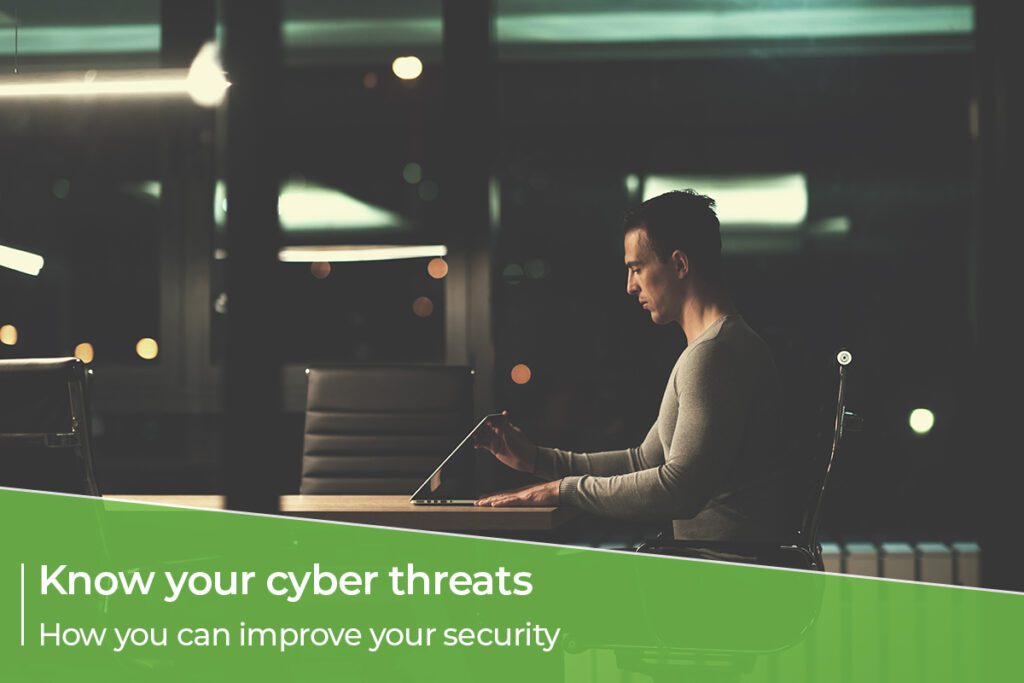In the previous blog in the series we explored cyber threats that utilize the user as their vessel to your data. In this, the last blog of the series, we will explore what you, the manager/owner, can do to improve your business cyber security.
Firewalls
What are they?
A Firewall is the ultimate barrier sitting on the edge of your network. It separates you and your ‘trusted’ network from the internet (the untrusted network). If you consider the door to your house, it allows and denies access; when access is permitted the door is open and monitored for who enters – when access is not permitted it is closed and shutting anything unwanted out. This is the way Firewalls work.
A Firewall prevents those that are not permitted from accessing the network, thereby stopping them from being able to gain control or visibility of your data or systems, all whilst providing secure access for those external to your network that you wish to permit access. This could include the provision of a VPN or certain network ports being open to third party services, such as a VoIP phone system.
How do I go about configuring a Firewall?
For small to medium businesses with only a handful of end-point devices you can implement Firewall software at device level. But this does depend completely on the size of the organization. A Firewall combined with other measures, such as anti-malware software, and being diligent with your patch management should ensure your network’s security. More on these later in the blog.
When dealing with a larger business, device-level Firewalls would not do their job properly, they would be impractical, and difficult to manage. Therefore, they require the use of boundary Firewalls, and you should at the very least invest in a physical or cloud-hosted Firewall server.
Access controls
User accounts in your business facilitate access, allowing the use of applications, devices, and sensitive information (contact details, bank details, personal information of any kind, etc). Only allowing access to authorised personnel with user accounts that mirror their station within the business dramatically reduces the risk of information being stolen or damaged.
If accounts with special access privileges to devices, applications, and information are compromised severely enough then the possible ramifications are not worth thinking about because the entire business could be incapacitated beyond repair. In extreme circumstances they can be exploited to facilitate a large-scale attack on your systems – causing long-term detrimental effects to all aspects of your business, from reputation to functionality.
In short, only allow access to authorised personnel to the point at which they need it to complete their job role.
Malware protection
What is it?
Malware is any software that is designed with the intention of causing damage to a computer, server, client, or computer network. Malware has rapidly become the most common form of computer virus. They attack software and make copies of themselves, before sending themselves to any computer or device associated with their target.
Put up a fight against Malware!
Yes, Malware is unpredictable, and if sophisticated enough it can be very difficult to fight back against, but there are some measures you can take to be more secure:
- Only download apps for mobile phones and tablets that are from manufacturer-approved shops. Apps from unknown sources will not have been checked for Malware! Be sure your staff do not download apps from these sources. However, there are manufacturer-approved shops that are universally safe to use, such as Google Play and the Apple App store, which are constantly monitored to ensure they provide a certain level of protection from Malware.
- Install Anti-Virus software on all computers, both at work and at home. Most popular operating systems include a free type of Anti-Virus software, but, unfortunately, these tools are usually very basic and offer a very limited level of protection which are almost definitely not sufficient to ensure you feel comfortable about being secure. It is very easy to use and is as simple as clicking ‘enable’ once downloaded. Smartphones and tablets can require different methods, but all contain end-user device (EUD) security guidance which is easy to find online.
- Run your apps in a ‘Sandbox’. Running your Apps in a Sandbox stops them from communicating with other parts of your network or device so they cannot be harmed.
Up-to-date software
Keeping your software and devices up-to-date is of paramount importance. If your devices aren’t equipped with the latest protection, you are leaving yourself vulnerable to problems and potentially business-incapacitating damage to your computer systems. Presuming your devices are immune because they are off-premise could be a potentially disastrous mistake.
Updates are the key. Part of the reason that manufacturers release updates is for you, the consumer, to get more from your device with new features that improve its functionality. But this is not the only reason – their main function is to remedy any security vulnerabilities that have been discovered. Wherever possible set updates to automatic. A manufacturer will remedy any security issues ASAP (as it is beneficial to them that you get the most from your device in a secure way), and a security breach could mean you losing faith in the device or software and possibly in the manufacturer as well.
Technology and IT has a lifespan and is constantly changing and evolving – with new tech being produced every day. Manufacturers are constantly finding new ways to get the most out of your technology in the securest way possible. But with these advancements in technology and, in turn, the levels of security capable within your tech, Malware is evolving just as quickly.
This means that updates need to be regular, as inconvenient as this can be. With the evolution of tech there is no chance of it slowing down – if anything it will only gain momentum. If a device or software in your possession stops being supported by the provider it is imperative that you purchase a modern, supported replacement ASAP.
Even once you have educated your employees to the best of your knowledge and put in all the cyber security measures you can, there is still the opportunity for human error and cyber criminals succeeding in breaching your defences. In this eventuality it is essential you have good data backup.
Let’s explore data backup.
Data backup
As we have already established, cyber attacks are on the rise. With this in mind, it is more important than ever to have an effective backup strategy in place to safeguard the IT systems and data that your business relies on.
Use the 3-2-1 backup rule. This is where three copies of the data exist, two should be on separate storage media and one stored offsite (in the cloud, for example) for disaster recovery purposes. Basically, ensure you hold at least three copies of an item in separate locations, spreading them across multiple locations ensures your business continuity.
Data backup is all about risk management – spreading your access so all your eggs are not in the same basket. Data compromising events can take many forms – from hardware failure and cyber attacks to robbery, fire, and flooding – so having a plan to ensure data recoverability could result in saving your business.
Where to begin with Data Backup
With so many data backup options available and with businesses often requiring a tailored approach it’s hard to summarise how to perform a comprehensive data backup for all businesses. Below are a few basic rules to follow when it comes to data backup.:
- Take advantage of the many benefits of Cloud storage. The Cloud can act as a cost-effective, convenient, and easily accessible storage option. This is ideal for disaster recovery in the event of a serious disaster such as an office fire.
- Don’t be afraid to store data in more than three locations – just make sure you keep track of where everything is.
- Keep physical copies of documents where appropriate. Filing cabinets are starting to feel like they belong in the past but there is no harm in storing paper copies of some files.
- Storage is cheaper than ever, so instead of picking and choosing individual documents why not just back everything up?
With what we have covered across the blog series you should now be in good stead and prepared for a cyber attack or, if the worst is to happen, be backed up so you can continue trading and survive the attack.
Keeping your team safe online – Grapevine
Are you concerned your systems are not cyber secure? Is your team properly educated on cyber security? Need some help? Grapevine can guide you to a future in which you no longer need to be concerned about the security of your digital landscape. Our years of experience ensure we are primed and ready with all the tools needed to ensure a top-quality service, now and into the future. Contact our team and let us start our journey together today.


